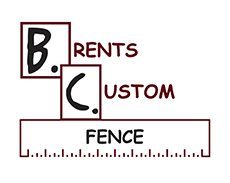Why Wire Fencing Offers Best Versatility for Every Property

Wire fencing comes in several main types, each designed for specific applications and security needs:
- Woven Wire: Flexible field fence perfect for livestock and uneven terrain
- Welded Wire: Rigid mesh ideal for gardens, pet runs, and utility areas
- Barbed Wire: Traditional deterrent for cattle and large property boundaries
- High-Tensile Wire: Strong, low-maintenance option for large pastures
- Hog Wire: Heavy-duty panels combining security with visibility
Whether you’re protecting your garden from rabbits, containing livestock, or securing property boundaries, wire fencing delivers practical solutions that won’t break the bank. Unlike solid fencing options, wire fences maintain visibility while providing effective barriers – making them perfect for homeowners who want security without sacrificing their view or creating an unwelcoming fortress-like appearance.
The global wire and cable market reached $215.6 billion in 2022, with the fencing segment growing at 5.2% annually. This growth reflects what property owners already know: wire fencing works.
From chicken wire that keeps pests out of vegetable gardens to high-tensile systems that contain horses across hundreds of acres, wire fencing adapts to your specific needs. The key lies in understanding which type matches your goals – whether that’s keeping children and pets safe, deterring intruders, or maintaining livestock.
Modern wire fencing also integrates beautifully with landscaping. Galvanized finishes resist rust for 15-25 years, while vinyl-coated options add color and softer edges around play areas. Many homeowners find that the right wire fence actually improves their property’s appearance while solving practical problems.
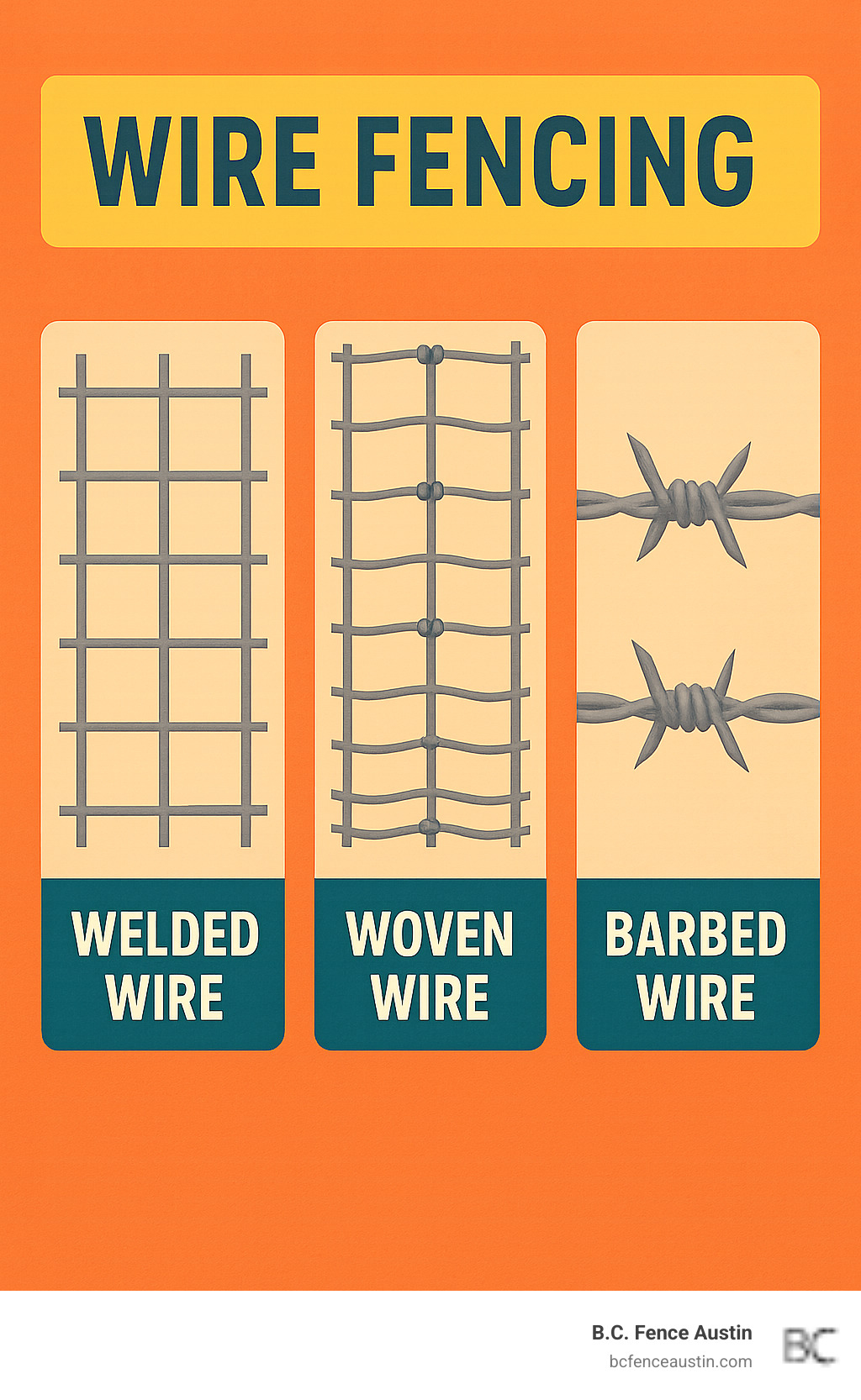
Wire fencing terms you need:
A Guide to Common Wire Fence Types
Choosing the right wire fencing is like picking the perfect tool for a job—each type has its own strengths. Whether you’re containing curious goats, protecting a prized garden, or securing hundreds of acres, there’s a wire fence designed for your situation.
Woven Wire and Field Fence
Picture a fence that bends but doesn’t break—that’s the beauty of woven wire. This wire fencing gets its flexibility from a design where wires wrap around each other at every intersection, creating knots. This design creates incredible strength.
What makes woven wire truly special is its graduated mesh design. The openings start small at the bottom (perfect for keeping lambs in) and get progressively larger toward the top. It’s engineering that just makes sense – small animals stay put while you save money on materials.

The flexibility of woven wire really shines on uneven terrain. While other fences might need expensive grading, woven wire rolls with the hills and valleys like it was born there. This makes it perfect for small livestock containment – sheep, goats, and even chickens feel right at home behind a woven wire boundary.
You’ll find different knot types too, from hinge-joint (more flexible) to fixed-knot (more rigid). Each serves different animals and situations. For a deeper dive into farm applications, check out our guide on Best Options for Farm Fencing.
Welded Wire Mesh
If woven wire is the flexible friend, welded wire mesh is the reliable perfectionist. Every intersection gets welded together, creating a rigid grid pattern that stays put year after year. No sagging, no shifting – just clean, straight lines that look as good as they perform.
This rigidity makes welded wire mesh perfect for garden protection. Rabbits and deer take one look at that uniform barrier and usually decide your vegetables aren’t worth the effort. The clean sight lines mean you can still admire your tomatoes while keeping the critters at bay.
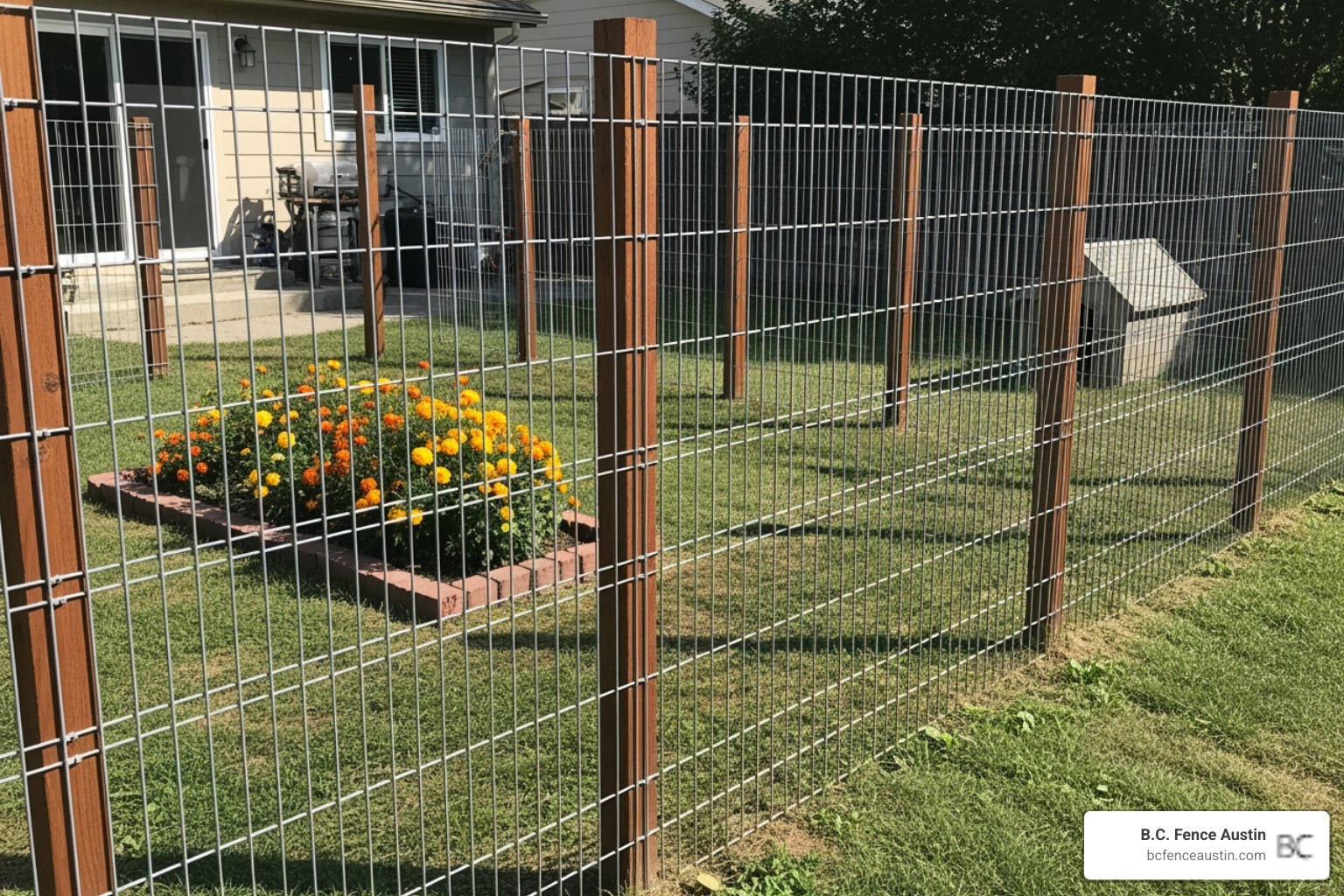
Pet enclosures are another sweet spot for welded wire. Dogs get a secure boundary they can’t push around, and you get peace of mind. The mesh also works beautifully for utility panels – temporary barriers, storage area divisions, or even decorative applications where you want something sturdy but not imposing.
For homeowners exploring different options, our insights on Chain Link Fence Alternatives show how welded wire can offer a cleaner look with similar security benefits.
Barbed and Barbless Wire
Barbed wire carries some serious history – it literally shaped the American West. Those sharp barbs spaced along smooth wire create both a physical deterrent and a psychological barrier that’s hard to ignore. Animals learn quickly to respect that boundary.
For cattle containment across large areas, barbed wire remains unbeatable. It’s straightforward, effective, and covers vast property boundaries without breaking the budget. The mere sight of those barbs sends a clear message to both animals and people.
But here’s the thing about barbed wire – those barbs don’t discriminate. They’ll cut a panicking horse just as easily as they’ll deter a wandering cow. That’s why we often recommend barbless wire for situations where you want the psychological effect without the injury risk.
Safety considerations matter enormously with barbed wire. It’s fantastic for cattle but potentially dangerous for horses, pets, or anywhere children might play. For detailed information about this traditional option, visit our page on Barbed Wire Fence.
High-Tensile Smooth Wire
Think of high-tensile smooth wire as the marathon athlete of wire fencing. Made from high-carbon steel, it boasts incredible strength and durability that lets you space posts much wider – sometimes 20-30 feet apart instead of the usual 8-12 feet.
That wider spacing means fewer posts, less digging, and faster installation across large pastures. The low maintenance aspect is a real winner too – properly installed high-tensile wire can last decades with minimal attention.
The real magic happens with electrification potential. Add a charge to high-tensile wire and you’ve got a psychological barrier that teaches animals to respect the fence without physical force. It’s particularly brilliant for rotational grazing systems where you need flexible, effective boundaries.
The smooth surface makes it much safer for horses than barbed wire, while the thin profile maintains excellent visibility across your property. For comprehensive information about large-property solutions, explore our Ranch Fencing Options.
| Fence Type | Best Use | Strength | Visibility | Common Animal Applications |
|---|---|---|---|---|
| Woven Wire | Agricultural, livestock containment, uneven terrain | Excellent (flexes with impact) | Moderate | Sheep, Goats, Chickens, Cattle, Horses |
| Welded Wire | Gardens, pet runs, utility, decorative | Good (rigid, resists sagging) | High (clean grid) | Small pets, Poultry, Garden protection |
| Barbed Wire | Large property boundaries, cattle containment | High (physical & psychological deterrent) | Moderate | Cattle, Hogs, Property lines |
| High-Tensile Smooth | Large pastures, rotational grazing | Excellent (high-carbon steel) | High (thin strands) | Cattle, Horses (electrified), Sheep, Goats |
Understanding the Nuts and Bolts of Wire Fencing
This section explains the technical specifications that determine a fence’s performance and longevity.
Choosing the right wire fencing goes beyond picking a style that looks good. The real magic happens in the details – the wire thickness, mesh openings, and protective coatings that determine whether your fence will still be standing strong in twenty years or start sagging after the first winter storm.
Think of these technical specs as your fence’s DNA. Get them right, and you’ll have a reliable barrier that does its job year after year. Get them wrong, and you might find yourself dealing with escaped animals, frustrated neighbors, or expensive repairs sooner than you’d like.
Decoding Wire Gauge and Mesh Size
Wire gauge works backwards from what you might expect – the lower the number, the thicker the wire. It’s like golf scores in that way. A 12.5-gauge wire is much beefier than a 20-gauge wire, which means it’s stronger and will last longer under pressure.
For most farm applications, you’ll see wire between 12.5 and 14 gauge. This thickness strikes the right balance between strength and cost. Heavy-duty applications like containing large livestock or securing property boundaries often use even thicker gauges.
Mesh size – the dimensions of those openings in your fence – matters just as much as wire thickness. This is where you match your fence to your specific needs. A fence meant to keep chickens in needs much smaller openings than one designed for cattle.
Hardware cloth with 1/4-inch to 1/2-inch openings works perfectly for keeping rodents out of garden beds. Chicken wire typically features 1-inch mesh – just right for poultry but not much else. Welded wire mesh with 2-inch by 4-inch openings handles dogs and general-purpose fencing beautifully. Woven field fence often uses graduated mesh, with smaller 2-inch by 4-inch openings at the bottom growing to 6-inch by 6-inch at the top – perfect for containing everything from sheep to cattle in one fence.
The key is matching mesh size to your smallest animal or biggest threat. Sheep can squeeze through surprisingly small gaps, while a fence that stops cattle might let smaller livestock waltz right through.
Materials and Coatings for Durability
The heart of any good wire fencing is galvanized steel. This process coats steel wire with zinc, which acts like a bodyguard against rust and corrosion. The zinc takes the hit from weather and moisture, protecting the steel underneath.
Class 1 galvanization provides solid protection for most applications. Class 3 galvanization steps it up with a heavier zinc coating that can handle harsh climates and challenging soil conditions. If you’re dealing with salty air, acidic soil, or extreme weather, that extra coating pays for itself over time.
Zinc-aluminum coating represents the next generation of protection. This advanced coating combines the best of both metals, offering superior resistance to the elements compared to traditional galvanization.
PVC coating adds another layer of protection while bringing color options to the table. This plastic coating goes over the galvanized wire, providing extra defense against rust, scratches, and UV damage. It also creates a softer surface that’s safer around children and pets.
Stainless steel wire fencing exists for specialized applications where corrosion resistance is absolutely critical. It costs more upfront but delivers exceptional longevity in harsh environments.
Most quality galvanized wire fencing lasts 15-25 years, though this varies based on your local conditions. Coastal areas with salt air, regions with acidic soil, or places with extreme weather cycles can shorten that lifespan. Proper maintenance and choosing the right coating class for your situation can extend your fence’s life significantly.
Hog Wire for Predator Deterrence and Style
Hog wire panels bring serious strength to the wire fencing world. These heavy-duty panels, typically featuring 2×4 inch or 4×4 inch mesh openings, were originally designed to contain hogs and cattle. Today, they’re gaining popularity for their unique combination of toughness and style.
The numbers tell the story of why robust fencing matters. Property damage from wildlife costs Americans over $2.5 billion annually, with wild hogs and deer leading the charge. Hog wire’s strength makes it an excellent defense against these unwanted visitors.
What makes hog wire special is its dual personality. It’s tough enough for serious predator protection and livestock containment, yet clean-lined enough for residential use. Many homeowners pair hog wire panels with wooden frames to create a modern farmhouse look that’s both functional and beautiful.
The panels maintain excellent visibility while providing security – perfect for monitoring livestock or simply enjoying your view. Their pre-assembled design also speeds up installation compared to traditional roll fencing.
For creative applications and installation ideas, check out our Cattle Panel Fence Ideas and Guide.
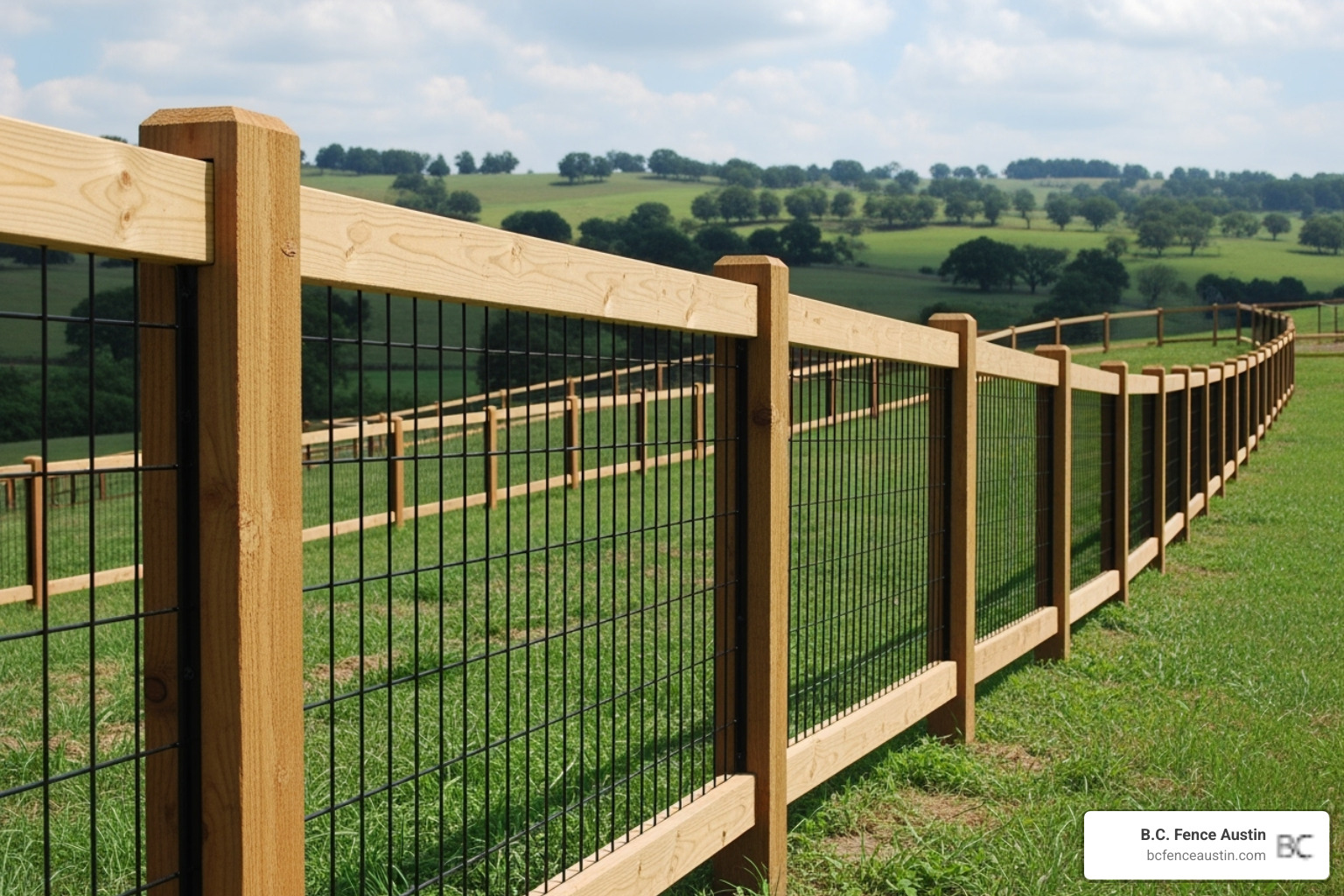
Installation and Maintenance Essentials
Proper installation and care are crucial for maximizing the life and effectiveness of your fence. Think of installing wire fencing like baking a cake – you can have the finest ingredients, but if you don’t follow the recipe, you’ll end up with a mess instead of something beautiful and functional.
Best Practices for Installing Wire Fencing
The difference between a fence that lasts five years and one that serves you faithfully for decades often comes down to installation quality. We’ve seen plenty of fences that looked great on day one but started sagging within months because corners were cut during setup.
Post selection forms the backbone of your entire system. Wooden posts offer a classic look and work beautifully for residential applications, while metal T-posts provide excellent reliability and punch through tough soil with ease. The key is matching your post choice to your specific wire fencing type and local soil conditions.
Post spacing makes or breaks your fence’s performance. High-tensile systems can handle wider spacing of 20-30 feet between posts, which saves both time and money on large properties. However, woven wire and barbed wire need closer attention, typically requiring posts every 8-12 feet to maintain proper support and prevent that dreaded sag that makes any fence look tired.
Your corner and brace assemblies deserve special attention because they’re the unsung heroes holding everything together. These stress points bear the brunt of wire tension, and skimping here means your entire fence line could fail. We always recommend robust corner construction – it’s like the foundation of a house, invisible but absolutely critical.
Tensioning your wire fencing properly requires a delicate balance. Too loose, and you’ll have sagging wire that animals can easily push through or under. Too tight, and the wire becomes brittle and prone to snapping during temperature changes or impact. We use specialized tools like wire stretchers and come-alongs to achieve that perfect tension that keeps everything taut without overdoing it.
The tools you’ll need vary depending on your project scope, but basic equipment includes post-hole diggers, wire cutters, fence pliers, and a sturdy hammer. For T-posts, a post driver makes installation much faster and easier on your back.
Before breaking ground, invest time in planning and marking your fence line. Walk the property, note any obstacles or terrain changes, and mark exact post locations. Rocky or uneven ground might require adjusting your spacing or stepping the fence to follow natural contours.
For additional insights on professional installation techniques, our Chain Link Fence Installation Tips offers valuable guidance that applies to many wire fencing projects.
Integrating Electric Fencing for Improved Control
Adding electricity to your wire fencing system transforms it from a physical barrier into a smart psychological deterrent. Animals quickly learn to respect an electric fence after just one or two encounters, making it incredibly effective for livestock control and predator deterrence.
The beauty of electric fencing lies in its psychological impact rather than physical strength. A single hot wire carrying 2,000 to 10,000 volts delivers a memorable but harmless shock that teaches animals to maintain their distance. This approach often proves more humane and effective than relying solely on physical barriers.
Adding a hot wire to existing wire fencing is surprisingly straightforward. You can run electrified strands above, below, or alongside your main fence line. Many ranchers add a hot wire at nose height for cattle or lower for smaller animals trying to dig underneath.
Insulators play a crucial role in keeping your system energized. These small but mighty components prevent electrical current from grounding out through fence posts, ensuring your hot wire stays hot and effective. Without proper insulation, your expensive energizer becomes useless.
A proper grounding system completes the electrical circuit and ensures effective shock delivery. Poor grounding is the most common reason electric fences fail to perform as expected. The ground rods need adequate contact with moist soil to work properly.
Safety considerations are paramount when working with electric fencing. While the shock is designed to be startling rather than harmful, proper installation and clear marking protect both animals and people from unexpected encounters.
For specific information about electrified options, visit our Barbed Electric Wire page.
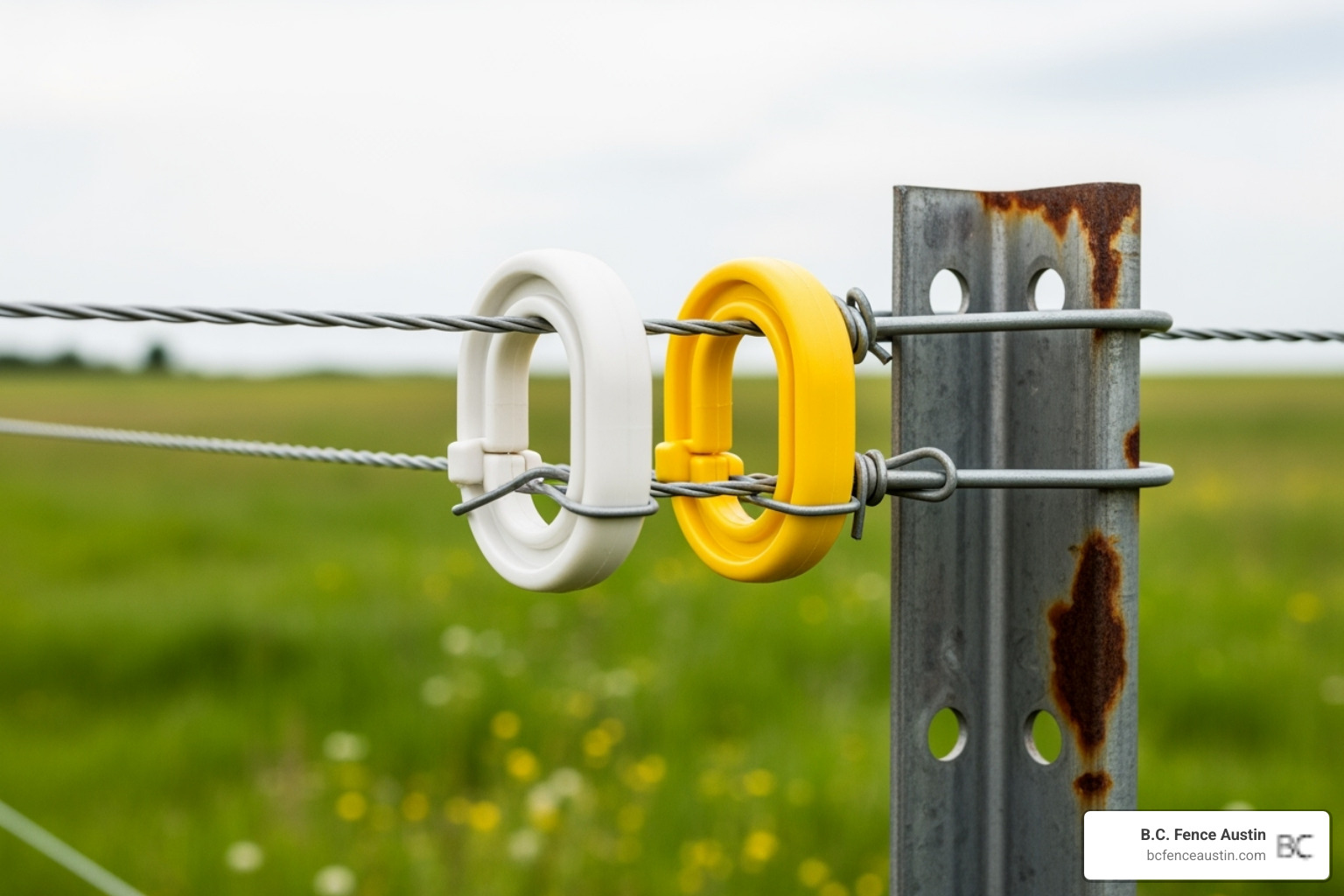
Maintaining Your Wire Fencing for Longevity
Even the toughest wire fencing needs regular attention to reach its full lifespan potential. Think of maintenance as preventive medicine – a little care now prevents major headaches later.
Regular inspections should become part of your routine, especially after storms or seasonal changes. Walk your fence line quarterly, looking for loose connections, sagging sections, or damaged posts. Catching small problems early prevents them from becoming expensive repairs that require replacing entire sections.
Checking tension periodically keeps your fence performing at its best. Weather changes, animal pressure, and natural settling can gradually reduce wire tension. When you notice sagging, use appropriate tools to restore proper tightness without over-tensioning.
Repairing damage promptly maintains the integrity of your entire system. A single broken wire or loose connection can compromise security along your entire fence line. Keep basic repair supplies on hand so you can address issues immediately rather than waiting for convenient shopping trips.
Vegetation control around your fence line serves multiple purposes. Overgrown weeds and vines add unnecessary weight and pressure to wires, while also creating moisture traps that accelerate rust formation. For electric systems, vegetation contact can ground out the current and render your hot wire ineffective.
Rust prevention extends the life of even galvanized wire fencing. Inspect coating integrity regularly, especially at connection points where wear is most common. Addressing compromised areas quickly prevents rust from spreading and weakening the wire structure.
Regular maintenance ensures your wire fencing continues protecting your property effectively throughout Austin, Cedar Park, Leander, Liberty Hill, Round Rock, Georgetown, Pflugerville, Lago Vista, and Jonestown for many years to come.
Frequently Asked Questions about Wire Fencing
When you’re considering wire fencing for your property, you’re definitely not alone in having questions. We’ve been helping Austin-area homeowners and ranchers choose the perfect fencing solutions for years, and certain questions come up again and again. Let’s tackle the big ones that might be on your mind too.
What is the best wire fence for keeping animals out of a garden?
Nothing’s more frustrating than watching rabbits turn your prize tomatoes into their personal salad bar! For garden protection, welded wire mesh is usually our go-to recommendation. Its rigid grid pattern and clean lines make it both effective and attractive around your landscaping.
The mesh size is absolutely crucial here. For most garden applications, a 2-inch x 4-inch welded wire mesh works beautifully against rabbits, squirrels, and other medium-sized garden raiders. If you’re dealing with smaller pests like mice or voles, you’ll want to step up to hardware cloth with its tiny 1/4-inch or 1/2-inch openings.
Chicken wire with its familiar hexagonal pattern is another solid choice, especially if you’re protecting against birds or need something temporary and budget-friendly. Just keep in mind it’s not as durable as welded wire for long-term installations.
Here’s the secret many gardeners miss: preventing digging is just as important as blocking climbing. We often recommend burying 6-12 inches of your fence below ground, or laying a horizontal apron of wire flat on the ground and covering it with mulch. Those persistent rabbits won’t know what hit them!
How long does galvanized wire fencing typically last?
This is probably the most practical question we hear, and for good reason – you want to know you’re making a smart investment. Quality galvanized wire fencing typically delivers 15-25 years of reliable service, which is pretty impressive for any outdoor installation.
The coating class makes a huge difference in longevity. Class 3 galvanization or modern zinc-aluminum coatings will outlast basic Class 1 coatings by several years, especially in challenging conditions. Think of it like buying quality paint for your house – the upfront investment pays off in the long run.
Your local climate plays a big role too. Here in Central Texas, our relatively dry climate is actually gentler on galvanized finishes than coastal areas with salt air or regions with constant humidity. However, areas with acidic soil or frequent flooding can be tougher on any metal fencing.
The real game-changer is maintenance. Fences that get regular inspections, prompt repairs, and vegetation control can easily exceed that 25-year mark. We’ve seen well-maintained galvanized wire fencing installations that look great after 30+ years of Texas weather.
Can I install a wire fence myself?
Absolutely! Many wire fencing projects are perfect for the DIY enthusiast, especially smaller gardens, pet runs, or straightforward property lines. We love seeing homeowners take pride in their own installations.
The key is being honest about your skill level and the project scope. Installing welded wire mesh around a garden bed? That’s definitely doable with basic tools like wire cutters, fence pliers, and a post-hole digger. You’ll feel great about the accomplishment, and your wallet will thank you too.
However, larger agricultural installations or high-tensile systems require specialized equipment like wire stretchers and come-alongs, plus the experience to achieve proper tension without over-stressing the wire. Corner braces and gate installations can also get tricky fast.
When should you call the professionals? If your project involves complex terrain, electric fencing integration, or covers significant acreage, it’s usually worth getting expert help. Poor installation can lead to premature failure, safety issues, or costly do-overs that eliminate any initial savings.
If you’re leaning toward DIY, check out our guide on Chain Link Fencing Supplies to get a feel for the tools and materials involved in similar wire installations. Sometimes seeing the full scope helps you decide whether to tackle it yourself or call in the pros.
Secure Your Property with the Right Fence
Finding the perfect wire fencing solution doesn’t have to feel overwhelming. Throughout this guide, we’ve walked through everything from the flexible strength of woven wire that hugs uneven terrain to the clean lines of welded wire mesh that keeps your garden pristine. We’ve explored how barbed wire still reigns supreme for large property boundaries, while high-tensile smooth wire offers that sweet spot of strength and economy for expansive pastures.
The beauty of wire fencing lies in its adaptability. Whether you need the heavy-duty protection of hog wire panels or the gentle containment of chicken wire, there’s a solution that matches your specific needs perfectly. And here’s what makes the difference between a fence that serves you well and one that becomes a constant headache: understanding those technical details we covered.
Wire gauge determines strength, mesh size controls what gets through, and quality coatings like Class 3 galvanization can mean the difference between a fence that lasts 15 years versus one that serves you faithfully for 25. Proper installation isn’t just about digging holes and stringing wire – it’s about strategic post spacing, rock-solid corner assemblies, and achieving that perfect tension that keeps everything secure without overstressing the materials.
The integration possibilities are exciting too. Adding electric fencing transforms a basic boundary into an intelligent barrier that teaches rather than simply blocks. And with consistent maintenance – those regular walks along your fence line, keeping vegetation at bay, and addressing small issues before they become big problems – your wire fencing investment will continue protecting what matters most.
At B.C. Fence Austin, we’ve seen how the right fence transforms properties across Austin, Cedar Park, Leander, Liberty Hill, Round Rock, Georgetown, Pflugerville, Lago Vista, and Jonestown. Wire fencing isn’t just about creating boundaries; it’s about enhancing your property’s security, functionality, and value while maintaining the aesthetic appeal that makes you proud to call it home.
Your property deserves fencing that works as hard as you do. Whether you’re protecting livestock, securing gardens, or defining property lines, we’re here to help you steer the options and find the perfect wire fencing solution that fits your unique situation.
Ready to get started? Contact us for your barbed wire fence needs or discuss any other fencing project. We’re excited to help you build something that truly works.
